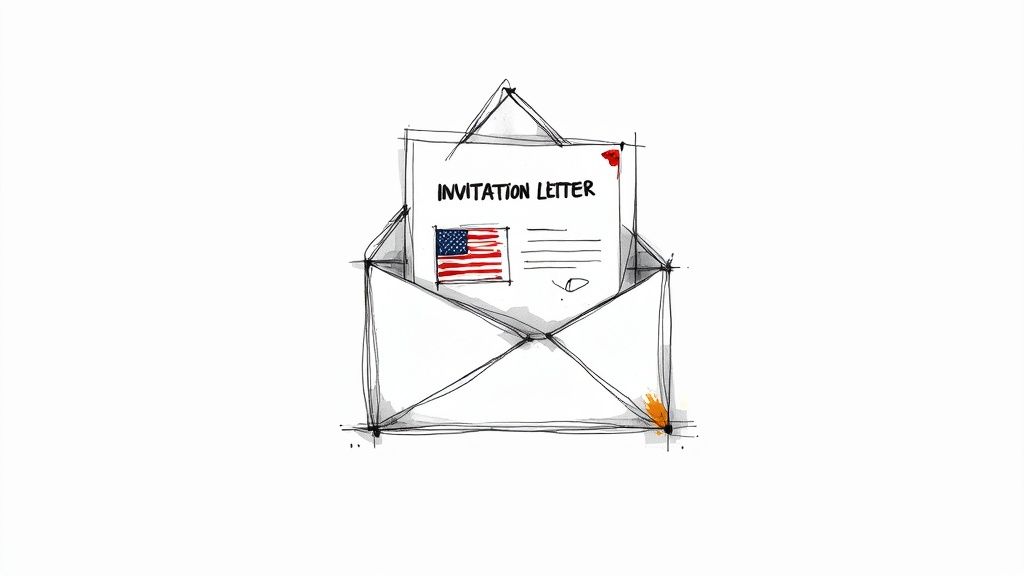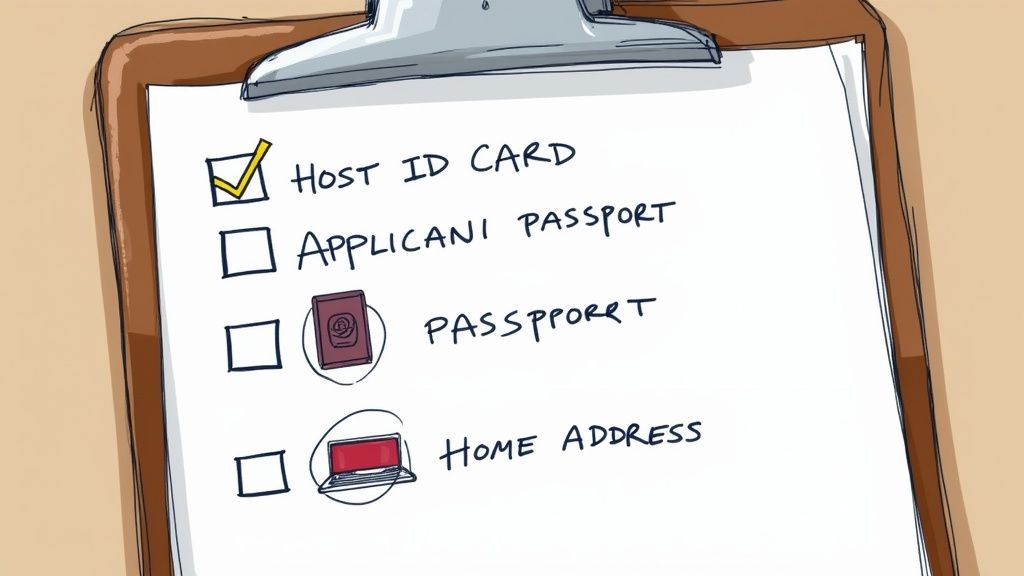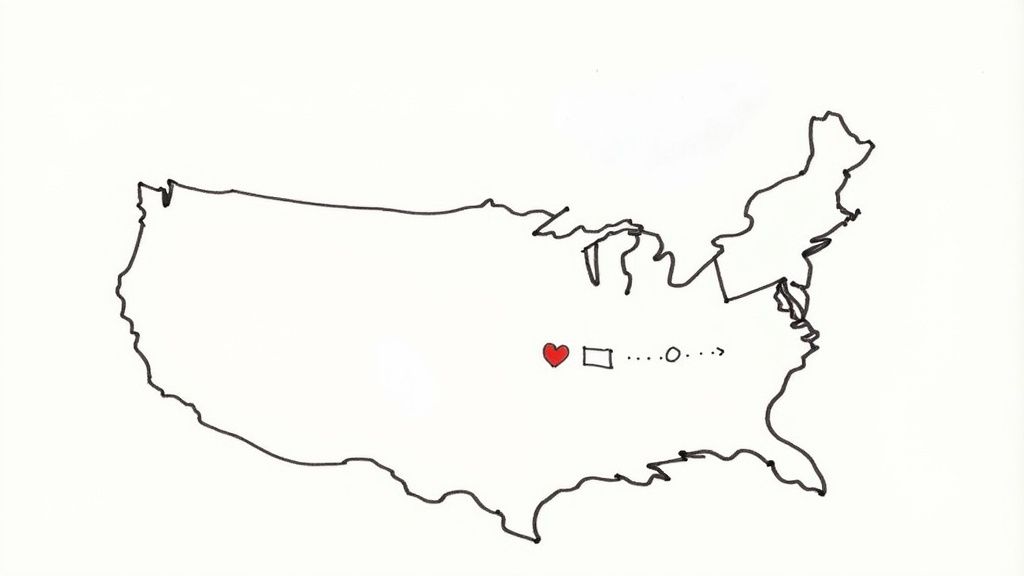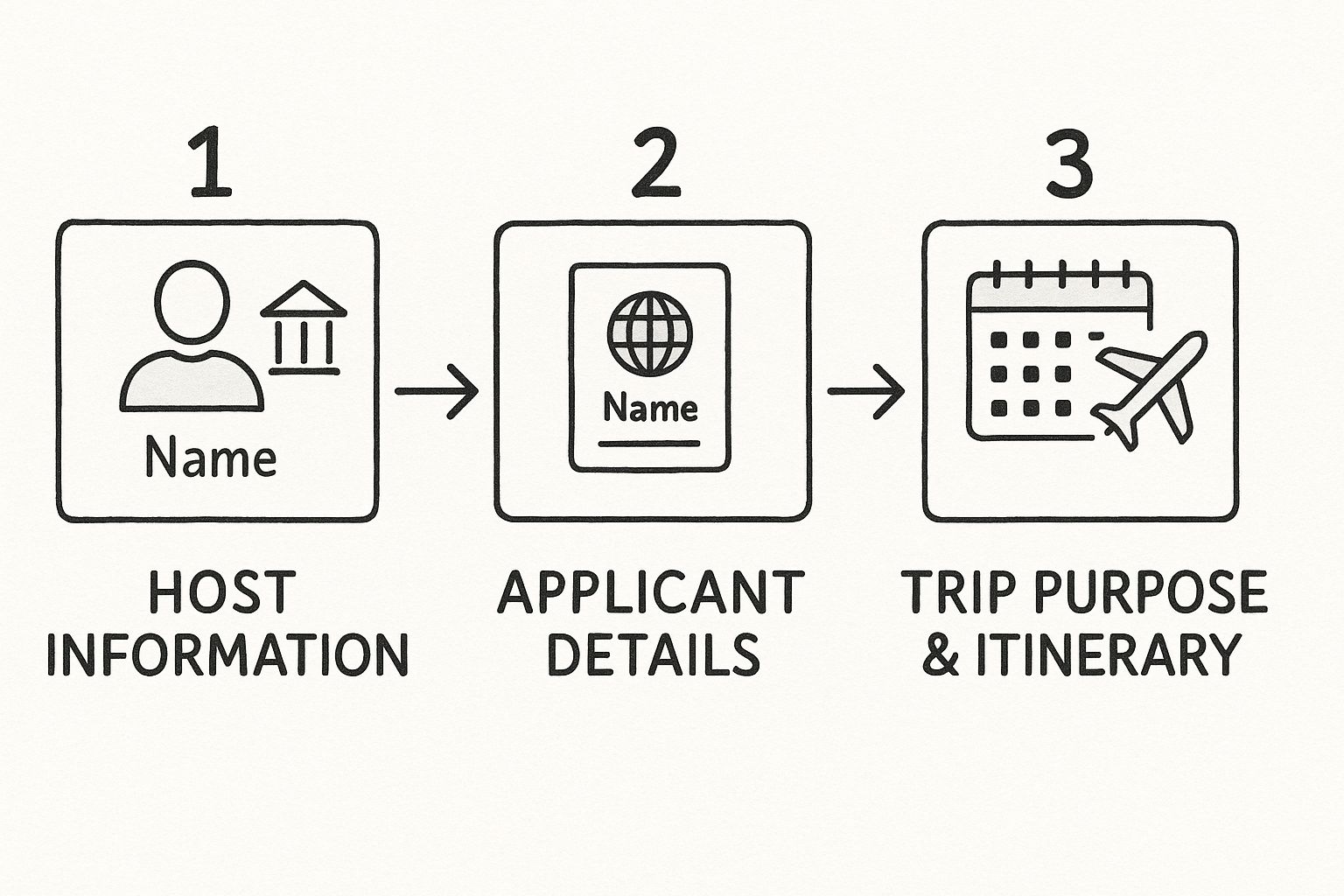A letter of invitation for a US visa is a personal letter written by a U.S. citizen or legal resident for someone applying for a B1/B2 tourist or business visa. Think of it as a character reference for your trip.
While it’s not an official, mandatory document on a government checklist, it carries a lot of weight. It’s a powerful supporting document that can genuinely strengthen a visa application by answering key questions the consular officer will have about your visit, especially for applicants from countries like Mexico, Colombia, and Brazil.
Understanding the Visa Invitation Letter

At its core, this letter is a personal note from your host in the U.S.—be it a friend, family member, or business associate—to the consular officer handling your case. Its main job is to add a human element and provide context to your application, making your travel plans feel more real and legitimate.
Here’s what it really does for your application:
- Explains the "Why": It clearly states the reason for your visit. Are you coming for a cousin's graduation in Chicago? A tech conference in San Francisco? Or just to visit a lifelong friend in Austin? The letter spells this out.
- Confirms a Place to Stay: It shows the officer you won't be stranded. By confirming you have accommodations, it eases concerns that you might become financially dependent on the U.S. government.
- Establishes a Real Connection: The letter demonstrates you have a genuine contact in the United States, which adds a layer of credibility to your story.
- Strengthens Your Intent to Return: By outlining a trip with a specific purpose and duration (like a two-week vacation), it reinforces the idea that you plan to go back home once your visit is over.
How It Strengthens Your Application
A well-written invitation letter can be a game-changer. Getting a visa interview slot can be tough enough, and the last thing you want is a weak application when you finally get your chance. While you figure out the US visa appointment booking process, your host can be getting this crucial document ready for you.
Expert Tip: One of the most common reasons for a B1/B2 visa denial is the failure to prove "nonimmigrant intent"—that is, convincing the consular officer you will leave the U.S. when your visit is complete. An invitation letter tackles this head-on by defining a temporary, specific stay.
To make things even clearer, let's break down who is responsible for providing which pieces of information in the letter.
Who Provides What in the Invitation Letter
This table gives you a quick summary of the essential details needed from both the person writing the letter (the host) and the person applying for the visa (the guest).
| Information Type | From the Host (Inviter) | From the Guest (Applicant) |
|---|---|---|
| Personal Details | Full name, U.S. address, and phone number. | Full name, date of birth, address, and passport number. |
| Legal Status | Proof of status (U.S. citizen or permanent resident), often with a copy of a passport or green card. | N/A (This is about the host's status). |
| Relationship | How they know the applicant (e.g., "my sister," "my college friend," "a business colleague"). | Confirms the relationship mentioned by the host. |
| Trip Details | The specific purpose of the visit and the planned dates of travel (arrival and departure). | Aligns with the travel dates and purpose stated in the DS-160 form. |
| Financial Responsibility | A statement clarifying who will cover the trip's expenses (e.g., "I will provide accommodation and meals"). | Evidence of their own funds if they are paying for the trip. |
Having all these details organized properly makes the letter far more effective and easier for the consular officer to review.
Distinguishing from an Affidavit of Support
It’s easy to get this letter confused with an Affidavit of Support (Form I-864), but they are completely different. An Affidavit of Support is a formal, legally binding contract where a U.S. sponsor guarantees they will financially support an immigrant.
The invitation letter for a B1/B2 visa, on the other hand, is an informal, non-binding document. It’s a good-faith statement that adds context to your application; it doesn’t create any legal financial obligations for your host.
What Every Invitation Letter Must Include

Think of your invitation letter as a straightforward summary that backs up the visa applicant's story. Consular officers are looking at countless applications a day, so a letter that gives them all the key information right away is going to be much more effective. Every detail you include helps build a credible picture of the trip.
Your letter needs to answer the officer's biggest questions before they even have to ask: Who are you? Who is your guest? What's your relationship? Why are they visiting, and who is footing the bill?
Let's break down exactly what you—the host—need to provide, and what information you'll need from the person you're inviting.
Information from the Host in the U.S.
First things first, you (the host) have to clearly establish who you are and your legal status in the United States. This confirms you're a real person who can legitimately invite someone to the country.
Make sure your letter includes:
- Your Full Legal Name: Use the name exactly as it appears on your passport or Green Card.
- Your Complete U.S. Address: This verifies where you live and often where your guest will be staying.
- A Phone Number and Email: Gives the consulate a way to reach you if they have questions.
- Your Legal Status: State it plainly, such as "I am a U.S. citizen" or "I am a Lawful Permanent Resident." This is a must-have, and you'll typically back it up by attaching a copy of your U.S. passport or Green Card to the letter.
Adding your occupation and some proof of your financial stability can also give the letter a serious boost. It shows the consular officer you’re a responsible individual who can actually support your guest if you say you will. While this letter isn't a formal financial guarantee, these details add a valuable layer of trust.
If you are covering all the expenses, it's a good idea to understand the difference between this letter and a formal affidavit of support for a tourist visa.
Information About the Visa Applicant
Next, the letter needs to clearly identify the person you're inviting. This information absolutely must match what’s on their passport and their DS-160 visa application form. Even a small inconsistency can create confusion and raise red flags.
Be sure to list these details for your guest:
- Their Full Legal Name: Again, exactly as it is on their passport.
- Their Date of Birth: Helps to confirm their identity.
- Their Home Address and Phone Number: This is important for establishing their ties to their home country.
- Their Passport Information: Include the passport number, plus the issuance and expiration dates.
- Your Relationship to Them: Be direct. "My mother," "my close friend of 10 years," or "a business colleague from XYZ Company."
The goal here is to make the connection between you and the applicant crystal clear. Your letter should paint a picture of a genuine relationship, which is fundamental to proving the visit is legitimate.
By carefully including all of these pieces, your letter becomes a powerful piece of evidence. It tells a complete, verifiable story, leaving little room for doubt and helping the consular officer feel confident in approving the visa.
Clearly Explaining the Purpose of Your Visit

This is the heart of the letter. It's where the host needs to tell the story of the visit, and it's arguably the most critical section. A vague explanation like "to visit me" is a red flag for a consular officer. The goal here is to paint a clear, credible picture of a temporary trip with a definite beginning and end.
Specificity is your best friend. Instead of saying "to visit family," provide the rich context that makes the trip real. A detailed reason transforms a simple request into a believable plan, showing the officer that this is a well-thought-out, legitimate visit.
Framing Different Visit Scenarios
How you frame the purpose depends entirely on the reason for the trip. The most important thing is to be honest and provide enough detail to make the situation understandable, no matter the scenario.
Let's look at a few ways to articulate the purpose effectively:
- For a Family Event: "My sister, [Applicant's Name], is coming to attend her niece’s wedding, which is being held on [Date] here in San Diego, California. She plans to stay with our family for three weeks, from [Start Date] to [End Date], to help us with the final preparations and, of course, to celebrate with everyone."
- For a Business Trip: "I am inviting [Applicant's Name], a software developer at [Their Company Name], to our main office in New York City. The reason for this B1 visa trip is for critical, in-person project planning sessions scheduled from [Start Date] to [End Date]." We cover more on this topic in our guide to business visa requirements for the US.
- For Medical Support: "My elderly mother, [Applicant's Name], needs to visit me in Houston, Texas, to provide crucial emotional and physical support. I am undergoing a medical procedure at the MD Anderson Cancer Center, and her presence during my treatment and recovery is essential. Her intended stay is from [Start Date] to [End Date]."
Notice how each example answers the who, what, where, when, and why. This level of detail removes any ambiguity and makes the visit feel tangible and real.
Outlining the Itinerary and Accommodations
After explaining the main purpose, it helps to briefly touch on the planned activities and confirm where the visitor will be staying. This doesn't have to be a minute-by-minute schedule, but a general outline adds a ton of credibility.
For example, the host could mention plans to visit specific landmarks, attend family gatherings, or participate in scheduled business meetings. It shows that thought has gone into the trip and it isn't just an excuse for an open-ended stay. In a recent fiscal year, the United States issued approximately 645,890 immigrant visas, and family-based petitions accounted for 68% of that total. These numbers show just how often consular officers are reviewing applications based on family ties, which makes a clear purpose even more vital.
Crucial Takeaway: The letter must be crystal clear about where the applicant will live during their stay. If they are staying at the host's home, the letter needs to state that explicitly and include the host’s address. This small detail directly answers a key question the officer will have about the visitor's financial stability and living arrangements.
Crafting the Perfect Invitation Letter: A Practical Template
Alright, let's move from the "what" to the "how." Theory is great, but seeing a real-world example is what makes it all click. I'm going to share a template that has worked time and time again for visa applicants.
Think of this not as a fill-in-the-blank form, but as a blueprint. The real magic happens when you and your host personalize it with your specific details, making it genuine and compelling. A good letter strikes that perfect balance between being personal and professional—exactly what a consular officer needs to see.
A Go-To Sample Letter
Here’s a solid structure you can adapt. Just be sure to swap out all the bracketed information with your host's and your own details.
[Your Full Name - Host]
[Your Full U.S. Address]
[Your Phone Number]
[Your Email Address]
[Date]
U.S. Consulate General
[Consulate Address - e.g., Bogota, Colombia]
Subject: Letter of Invitation for [Applicant's Full Name]
Dear Consular Officer,
My name is [Host's Full Name], and I am writing to formally invite my [Relationship to Applicant, e.g., mother, friend, colleague], [Applicant's Full Name], to visit me in the United States. I am a [U.S. Citizen / Lawful Permanent Resident].
[Applicant's Full Name] currently lives at [Applicant's Home Address]. Their date of birth is [Applicant's Date of Birth], and their passport number is [Applicant's Passport Number].
The purpose of this visit is to [State the specific purpose, e.g., attend my university graduation, for a two-week vacation to explore California, to be a guest at my wedding]. The planned dates for the trip are from [Start Date] to [End Date].
During their stay, [Applicant's Full Name] will be staying with me at my residence at the address listed above. I will be fully responsible for all their accommodation and meals. [If covering other costs, be specific, e.g., I will also cover the costs for their travel within the U.S.].
[Applicant's Full Name] has strong ties to their home country. They work as a [Applicant's Occupation] at [Applicant's Employer] in [Their Home City] and have every intention of returning to [Their Home Country] after their visit concludes.
I have attached a copy of my [U.S. Passport / Green Card] to this letter as proof of my legal status in the U.S. Please feel free to contact me if you require any additional information.
Sincerely,
[Host's Signature]
[Host's Printed Full Name]
Breaking Down the Template's Structure
Every single part of that letter has a job to do. The introduction gets straight to the point, identifying everyone involved. The middle paragraphs lay out the critical details—the why, when, where, and who's paying.
That final paragraph is absolutely crucial. It directly addresses the consular officer's main concern: proving the applicant will return home. Don't skip it.
This visual gives you a simple way to think about the letter's core components.

If you build your letter around these three pillars, you’re giving the consular officer a complete, credible, and easy-to-understand picture of the visit.
To make this even clearer, let's break down the role of each section in a quick summary table.
Anatomy of an Effective Invitation Letter
| Letter Section | What It Accomplishes | Example Key Phrase |
|---|---|---|
| Host’s Information | Establishes the host's identity and contact details for verification. | "My name is [Host's Full Name]... I reside at..." |
| Recipient & Subject | Immediately informs the consular officer of the letter's purpose. | "Subject: Letter of Invitation for [Applicant's Full Name]" |
| Introduction | Clearly states the relationship and the purpose of the invitation. | "I am writing to formally invite my [mother/friend]..." |
| Trip Details | Provides the essential facts: purpose, duration, and accommodation plans. | "The purpose of their visit is... from [Start Date] to [End Date]." |
| Financial Support | Explains who will be financially responsible for the trip's costs. | "I will be responsible for their accommodation and meals..." |
| Ties to Home Country | Reinforces the applicant's intent to return home after the visit. | "[Applicant's Name] is a [Job Title]... and intends to return..." |
| Closing | Offers further contact and includes the host's legal signature. | "Should you require any further information, please contact me." |
As you can see, there's a logical flow that guides the officer through the necessary information efficiently.
A Few Final Pointers on Tone and Format
The tone you're aiming for is respectful, direct, and factual. This isn't the place for overly emotional pleas like, "It would mean the world to me if you let them visit." Stick to the facts—they are far more persuasive.
Here are a few last-minute best practices to keep in mind:
- Always date the letter. This shows it’s current and specifically prepared for this application.
- Get a real signature. The host should physically sign the letter, which can then be scanned. It feels much more authentic than a typed or digital signature.
- Keep it to one page. Consular officers are busy. A concise, powerful letter is always better than a long, rambling one.
- Remember, this letter is just one part of your application. For a full rundown of everything you'll need, make sure to review a complete B-2 visa documents checklist.
By following this structure and advice, you can guide your host in creating a document that genuinely strengthens your visa application.
Common Mistakes That Can Weaken Your Application
Crafting a strong invitation letter isn't just about what you include; it's also about what you leave out. From my experience, I've seen a handful of common missteps that can instantly raise red flags for a consular officer, potentially jeopardizing an otherwise strong visa application. Knowing what these pitfalls are is the first step to avoiding them.
One of the most common errors I see is being far too general about the reason for the visit. A letter that vaguely states the applicant is coming "for a vacation" or to "discuss business" just doesn't cut it. This kind of ambiguity makes the trip seem poorly planned, or worse, can make the officer suspicious of the true intentions.
Vague Details vs. Specific Plans
Think of it from the consular officer's perspective: they need to see a clear, believable itinerary. Vague statements don't build trust; they create doubt. You need to provide concrete details that paint a complete and credible picture of the planned trip.
- Don't Do This: "I invite my friend Maria to visit me in Miami for a couple of weeks this summer."
- Do This Instead: "I am writing to invite my close friend of ten years, Maria Perez, to visit me in Miami from July 15th to July 30th, 2024. The main purpose of her visit is to be a guest at my wedding on July 20th and to spend time with my family."
The second example is much stronger because it gives names, specific dates, and a verifiable event—the wedding. It turns a generic request into a tangible, believable plan, which helps convince the officer of the visit's legitimate and temporary nature.
Unrealistic Financial Promises
Another critical mistake is making sweeping financial promises you can't back up. A host who simply writes, "I will pay for everything," without providing any proof of their financial stability, can actually hurt the application. It’s an easy claim to make, but without evidence, it holds very little weight.
The strongest letters align promises with proof. Instead of a blanket statement, specify exactly what you'll cover and attach supporting documents, like a recent bank statement or a letter from your employer, to show you have the means.
This demonstrates foresight and responsibility, adding a huge layer of credibility. For example, saying "I will provide accommodation in my home and cover the cost of her daily meals" is far more believable and easier to verify than a vague, all-encompassing promise.
Finally, resist the urge to use overly casual or emotional language. Phrasing like "we're begging for approval" or "we'll be heartbroken if she can't come" comes across as desperate and unprofessional. Stick to a respectful, factual, and confident tone.
Once your letter is polished and the visa is approved, the next hurdle is often finding an appointment. To get ahead, you can learn more in our guide on visa slot booking. Keeping your letter professional is the first step toward a successful application process.
Answering Your Final Questions About the Invitation Letter
Getting the invitation letter right can feel like the final, nerve-wracking piece of the puzzle. It's totally normal to have some last-minute questions. Let's clear up some of the most common ones we hear from visa applicants in countries across Latin America, Africa, and Europe, so you and your host can feel confident about your application.
Does the Invitation Letter Really Need to Be Notarized?
This is a big one, but the answer is simple: no, you typically don't need to get the letter of invitation notarized.
What the consular officer truly cares about is whether the letter is genuine and the information is true. Your host's sincere signature on a well-written letter is far more convincing than a notary's stamp. Just focus on making sure the letter is clear and that you have all the supporting documents to back it up. The goal is to prove your relationship is real and the trip has a legitimate purpose, which a notary can't do.
Who Can Actually Write an Invitation Letter?
The person writing your letter absolutely must be a U.S. citizen or a Lawful Permanent Resident (meaning they have a Green Card). This is a hard rule. They need to be able to prove their legal status in the United States.
It's also crucial that your host has a real, provable relationship with you. It doesn't matter if they're a cousin inviting you from Colombia for a graduation, a lifelong friend for a visit from South Africa, or a business partner for a conference from the UK—that connection needs to be obvious.
What Documents Should My Host Send Along with the Letter?
Think of the supporting documents as the proof that backs up every claim in the letter. They are just as critical as the letter itself.
At a minimum, your host needs to include:
- Proof of Their Legal Status: A crisp, clear copy of their U.S. passport's bio page or the front and back of their Green Card.
- Proof They Can Support You (If Applicable): If your host mentioned they're covering your expenses, they need to show they can actually do it. A recent bank statement or an official employment verification letter works perfectly.
How Should My Host Get the Letter to Me?
Don't worry about international mail. A digital copy is all you need.
Your host in the U.S. can simply sign the letter, scan it, and email it to you as a PDF along with the scanned copies of their supporting documents. Just make sure the scans are high-quality and easy to read.
Before your interview, you'll need to print a physical copy of the entire package—the letter and all its attachments. Bring this printed packet with you. Having it ready to hand over if the consular officer asks shows you’re prepared, organized, and serious about your application.
Facing a long wait for a visa appointment is beyond frustrating. Instead of checking the calendar constantly, let Vast Fisa do the work. Our service automatically finds and books earlier appointment slots for you in countries like Brazil, Colombia, Mexico, South Africa, and more, potentially cutting months off your wait time. You focus on getting ready for your trip; we'll handle the appointment. Find your earlier US visa appointment today.
